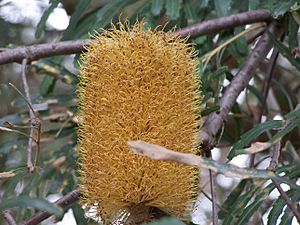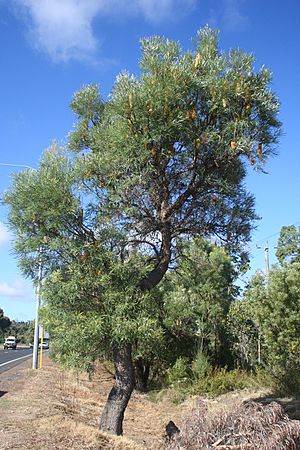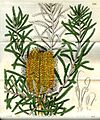Western Swamp Banksia facts for kids
Quick facts for kids Western Swamp Banksia |
|
|---|---|
 |
|
| Swamp banksia, cultivated plant in Kings Park | |
| Scientific classification | |
| Genus: |
Banksia
|
| Species: |
littoralis
|
| Synonyms | |
|
|

The Banksia littoralis, often called the swamp banksia, swamp oak, river banksia, or seaside banksia, is a special tree. It is found only in the southwest part of Western Australia. The Noongar people, who are the traditional owners of this land, call this plant pungura, boongura, or gwangia. This tree has bark that feels rough and crumbly. Its leaves are long and thin, often with jagged edges, and they grow in circles around the stem. The swamp banksia produces bright yellow flowers and can have up to two hundred seed pods in each flower head.
Contents
What Does the Swamp Banksia Look Like?
The swamp banksia is a tree that usually grows to be about 1.5 to 12 meters (5 to 39 feet) tall. Sometimes, it can even reach up to 25 meters (82 feet) high. It has bark that is rough and crumbly, and its young stems are covered in soft, woolly hairs.
Leaves and Flowers
The leaves of the swamp banksia grow in groups called whorls, which means they circle around the stem. They are long and narrow, typically 70 to 230 millimeters (2.8 to 9.1 inches) long and 4 to 18 millimeters (0.16 to 0.71 inches) wide. The top half of the leaves often has small, saw-like teeth. Each leaf sits on a short stalk, about 5 to 10 millimeters (0.20 to 0.39 inches) long.
The bright yellow flowers grow in a cylindrical shape, like a bottle brush. Each flower head is usually 70 to 200 millimeters (2.8 to 7.9 inches) long and 60 to 70 millimeters (2.4 to 2.8 inches) wide when the flowers open. The individual flowers are about 25 to 27 millimeters (0.98 to 1.06 inches) long. They have a special hooked part called a pistil, which is about 29 to 35 millimeters (1.1 to 1.4 inches) long.
When Does it Flower and Produce Seeds?
Swamp banksia trees usually flower from March to July. After the flowers fade, they form seed pods, called follicles. These pods are long and narrow, measuring 11 to 22 millimeters (0.43 to 0.87 inches) long, 2.5 to 8 millimeters (0.098 to 0.315 inches) high, and 4 to 8 millimeters (0.16 to 0.31 inches) wide. Each flower head can hold up to two hundred of these seed pods.
Where Does the Swamp Banksia Grow?
The swamp banksia lives in coastal areas of southwestern Western Australia. You can find it in regions like the Wheatbelt, Peel, South West, and Great Southern. It loves places with lots of moisture.
Preferred Habitat
This tree often grows along creeks and rivers, or in low-lying areas that get wet during certain times of the year, like swamps and depressions. It grows very well in peaty or sandy soils that hold a lot of water.
The swamp banksia is often part of low woodland areas. It frequently grows alongside another tree called Melaleuca preissiana and in forests of Eucalyptus gomphocephala. You might also find it in low coastal shrublands, but this is less common. Its range stretches from Mount Lesueur in the north down to Cape Leeuwin in the southwest, and east to places like Two Peoples Bay and the Stirling Range.
Growing Swamp Banksia in Your Garden
The swamp banksia is a relatively easy plant to grow in gardens. It is not as sensitive to a plant disease called dieback as some other banksia species from Western Australia. Dieback is a serious disease that can kill many native plants.
If you want to grow a swamp banksia from seeds, you don't need to do anything special to them. The seeds usually sprout within 20 to 36 days.
Images for kids
See also
 In Spanish: Banksia littoralis para niños
In Spanish: Banksia littoralis para niños
Taylor, Anne; Hopper, Stephen (1988). The Banksia Atlas (Australian Flora and Fauna Series Number 8). Canberra: Australian Government Publishing Service. ISBN 0-644-07124-9.





